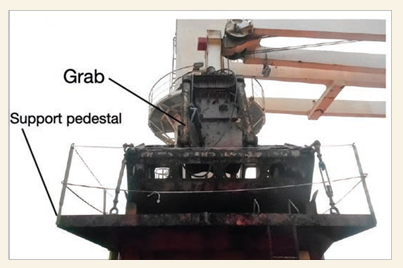202408 : Fatal fall
A vessel at anchor was to unload cargo using its own grabs. The grabs needed to be secured to the crane hooks for unloading.
As published by the Dutch Safety Board, March 2022 https://tinyurl.com/MARS202408
The grabs were secured on pedestals that protruded two and a half metres above the deck. Given the height of each grab, the top of the grab to which the crane hook had to be attached was more than six and a half metres above the deck.
The rigging was carried out on all four ship cranes, but other jobs still needed attending to. One deck crew climbed onto the grab via the integrated steps on the grab to release a lashing. The crane operator moved the hook towards the grab. Two ABs used a messenger line to guide the crane hook while the AB on the grab was still working to release the lashing.
The lifting block on the crane swung and hit the crewmember working at the lashing. The victim fell backwards to the deck below, landing on his head. None of the crew members involved were wearing the PPE required, such as a helmet, or using fall protection even though this equipment was available on board.
The Master was informed of the accident and the victim was attended to. He was soon transported to a shore hospital, but his condition worsened en route. On arrival at the hospital he was confirmed deceased. During the investigation, it was not possible to determine with certainty why the lifting block suddenly swung.

Lessons learned
- Walk the talk? Wearing correct PPE was apparently discussed during the earlier toolbox meeting, including the use of fall protection when working at height. However, during the work, no crew members wore proper PPE or used fall protection, nor did the duty officer object to this practice.
- Management’s commitment to safety and the ensuing trust relationship that is created with crewmembers are key elements of a robust safety culture. Senior vessel leaders must walk the talk.
